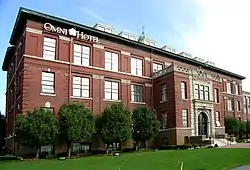Riverwalk Hotel Detroit
The Roberts Riverwalk Hotel and Residence Detroit, formerly the Parke-Davis Research Laboratory also once known as Building 55-Detroit Research,[3] is located on Joseph Campau Street at the Detroit River, in Detroit, Michigan. The former research facility was redeveloped as a boutique luxury hotel located on the Detroit International Riverfront.[4] The building was designated a National Historic Landmark in 1976 for its historic significance as an early research laboratory.[1]
Parke-Davis Research Laboratory | |
 Roberts Riverwalk Hotel Detroit | |
| Location | Detroit, Michigan |
|---|---|
| Coordinates | 42°20′13″N 83°0′52″W |
| Built | 1873, 1902 |
| Architect | Donaldson and Meier, Albert Kahn |
| Architectural style | Romanesque Revival |
| NRHP reference No. | 76001039 |
| Significant dates | |
| Added to NRHP | May 11, 1976[1] |
| Designated NHL | May 11, 1976[2] |
History
Parke-Davis moved its facilities to this location along the Detroit River in the 1870s to take advantage of the transportation provided by the river and nearby rail lines.[5] The company eventually built 26 still-extant buildings in the area; the Park-Davis campus as a whole, now known as the Stroh River Place is recognized on the National Register of Historic Places. However, the most significant structure in the group, the Parke-Davis Research Laboratory, is individually recognized as a National Historic Landmark.
The Research Laboratory was built in 1902 after Parke-Davis relocated the Detroit Boat Club to Belle Isle.[6] The Detroit architectural firm of Donaldson & Meier designed the original building; later additions were designed by Albert Kahn.[6] The building is a three-story brick building measuring approximately 120 by 40 feet (37 by 12 m), and is typical example of public architecture of the period.[3]
Significance
This building was the first industrial research laboratory in the U.S. established for the specific purpose of conducting pharmacological research, inaugurating the commercial pure science approach which has driven the rapid development of pharmaceutical technology.[5][7]
Later history and current use
The research laboratory was declared a National Historic Landmark in 1976.[2][8] In 1979, Parke-Davis sold its property in Detroit, including the Research Laboratory, to the Stroh family (of Stroh Brewery Company).[6]
The complex has been redeveloped for mixed use. The laboratory was eventually remodeled and served as a hotel and residence. National Park Service staff had recommended withdrawal of landmark status in 2002 due to loss of the building's historic integrity during the conversion.[9]
The Roberts Riverwalk Hotel & Residence Detroit opened May 2011.[10]
Gallery
.jpg.webp) Rear of the Parke-Davis lab, now the entrance.
Rear of the Parke-Davis lab, now the entrance. Door facing Detroit River.
Door facing Detroit River.
References
- "National Register Information System". National Register of Historic Places. National Park Service. January 23, 2007.
- "Parke-Davis Research Laboratory". National Historic Landmark summary listing. National Park Service. Archived from the original on 2008-06-07. Retrieved 2008-05-03.
- Parke-Davis Research Laboratory Archived 2011-06-06 at the Wayback Machine from the state of Michigan
- Parke Davis Research Laboratory/ Parke Davis Building #55/ Omni Hotel from Detroit1701.org
- Parke-Davis and Company Plant and Research Laboratory from the National Park Service.
- Sobocinski, Melanie Grunow; Ronnick, Michele Valerie; Beaudoen, Marlise; Gallery, Alfred Berkowitz (2005). Detroit and Rome: Building on the Past. Dearborn: The Regents of the University of Michigan. p. 97. ISBN 0-933691-09-2.
- Parke-Davis Research Laboratory from the state of Michigan Dept of History & Libraries
- Note: A National Register of Historic Places Inventory-Nomination document should be available upon request from the National Park Service for this site, but it appears not to be available on-line from the NPS Focus search site.
- Parke-Davis Research Laboratory Archived 2008-06-07 at the Wayback Machine from the National Historic Landmarks Program
- "Roberts Riverwalk Hotel Detroit". Roberts Riverwalk Hotel Detroit.
External links
| Wikimedia Commons has media related to Omni Detroit Hotel at River Place. |
- Official website
- Historic American Engineering Record (HAER) No. MI-19, "Parke-Davis Industrial Site, Bounded by MacDougall & Joseph Campau Avenues, Detroit, Wayne County, MI", 20 photos, 3 data pages, covers a number of related buildings but apparently not this one, if it is correct that this one is Building 55.




